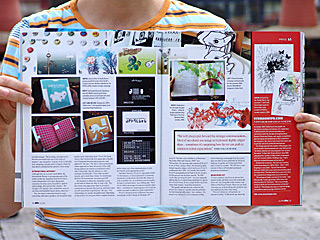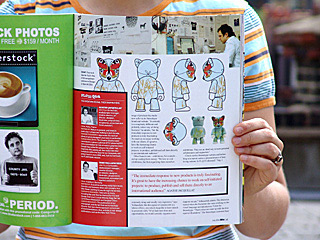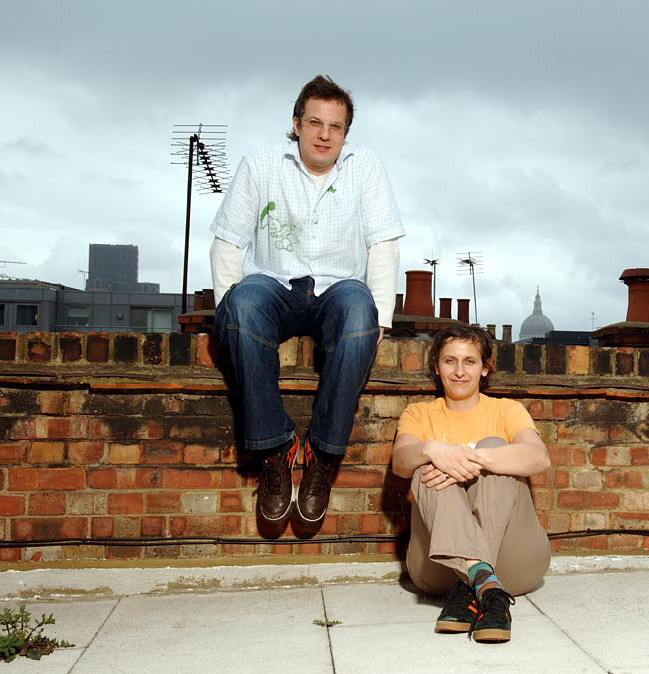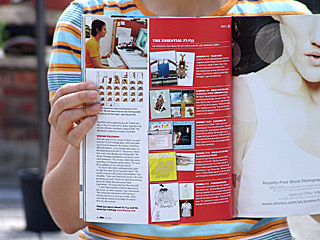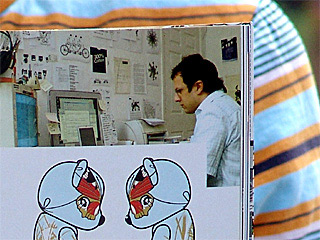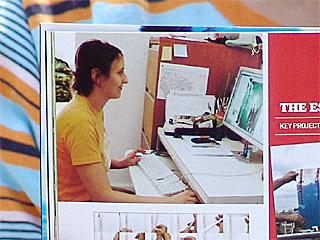PRESS ARCHIVE
Computer Arts, 124, July issue, 6-page FL@33 profile and interview, by Mark Penfold, FL@33 portrait photography on the roof of FL@33 HQ: Gavin Roberts, featuring various FL@33 works, pp.40–46, London, UK, June 2006 (English)
download pdf for complete profile, approx. 0.4mb
___
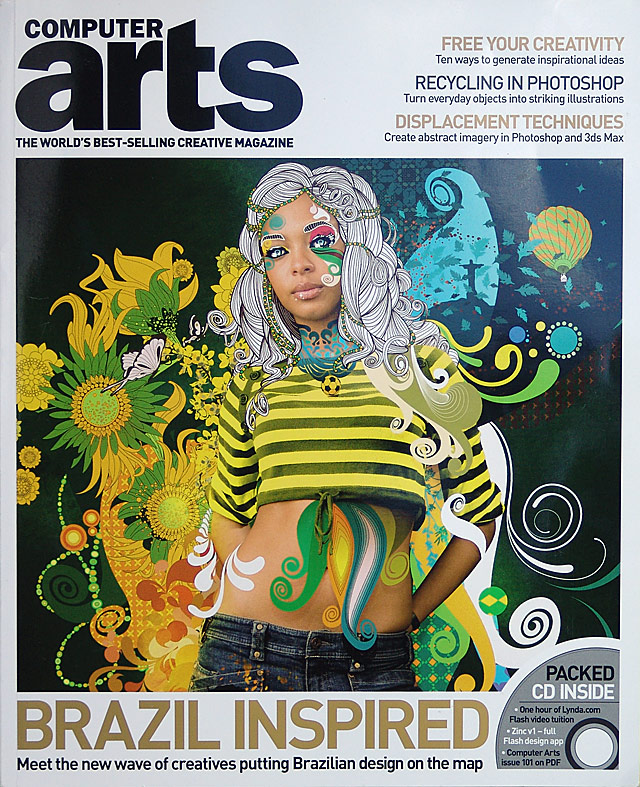
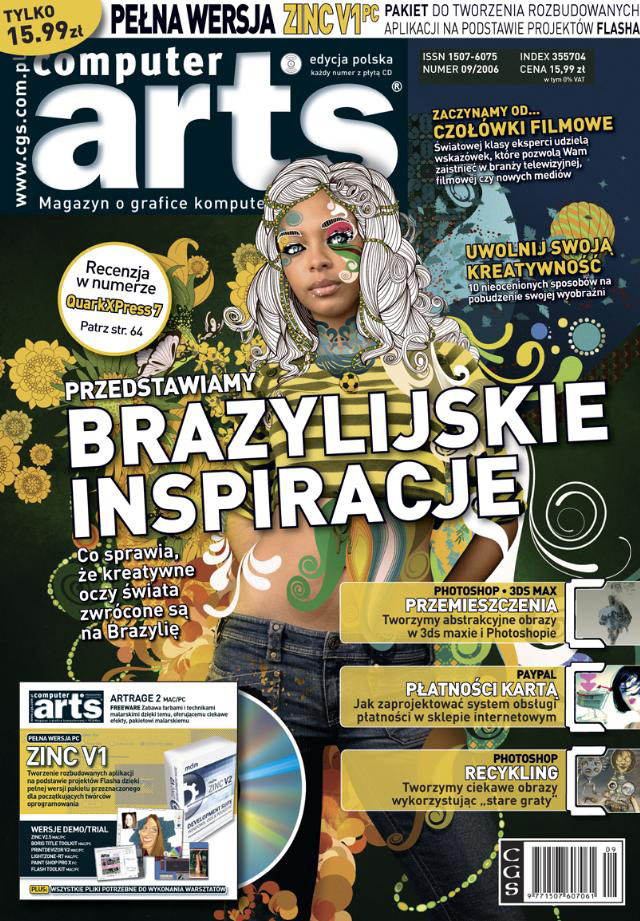
COMPUTER ARTS | FL@33 PROFILE (EXCERPT)
Since they met at the RCA in 1999, the multi-lingual, multi-national and multidisciplinary Agathe Jacquillat and Tomi Vollauschek have become designers sans frontières. Mark Penfold meets the design team selling its work, and squirrels, to an international audience.
___ For clued-up clients including the Young Vic theatre, Sacla and MTV, FL@33 produces work that speaks of an unfettered mind. Agathe Jacquillat and Tomi Vollauschek aren’t forcing the multi-X approach – promising fresh and interesting solutions, they strive to avoid stereotyping their work. It’s strange then that the agency has given its online retail experiment the name Stereohype. This is an outlet for self-commissioned work in the form of creative T-shirts, cards, prints, toys and books. You name it, FL@33 can do it.
___ Although the team has recently moved to more salubrious lodgings in Clerkenwell, London, until last year the office was based in a flat in Notting Hill. “And, you guessed it, the flat number was 33,” explains Tomi Vollauschek. Hence the name.
___ That, of course, is the short answer. “The extended one,” Vollauschek continues, “is a never-ending story about how difficult it is to have an @ sign in a company name. We love the number, but we don’t know what we were thinking when we came up with the @ sign.” Jacquillat interjects: “When we changed our partnership to a limited company in 2005, we considered dropping the @.” In the end, the pair relented because, after all, “It’s got character.” But, she laments, “You wouldn’t believe the amount of typos in our mail addresses.”
| Keeping it fresh | FL@33 isn’t afraid of diversity, so much so that its website proclaims that the studio is multi-specialised. The fashion for...
(...) CONTINUE READING
...specialisation that seems to have taken over the rest of the professional world is thankfully less evident in design. “We consider it very fashionable to offer a wide range of different creative approaches, techniques and media,” says Vollauschek.
___ And, as Jacquillat points out, it’s not just the media that is kept fluid: “FL@33’s mission is to create a professional, vibrant, fresh and artistic body of work,” she says. To achieve that, the agency must keep a balance between commissioned and self-initiated projects and publications. Vollauschek likes to keep things interesting: “It’s more challenging to do motion graphics today, a visual identity tomorrow, a poster the day after and a custom typeface afterwards.”
___ There’s a knock-on effect in terms of style, which many aspire to but few actually manage. “We’re trying very hard not to become associated with one or two styles or projects,” says Jacquillat. “Instead, we try to develop new, intriguing concepts and/or imagery whenever time allows and appropriate projects come along.”
| International interest | Although they try to avoid visual habits, the international flavour is an important part of the studio’s make-up. Jacquillat hails from France, while Vollauschek is of Austro-Hungarian extraction. In some cases, Jacquillat is quick to acknowledge, this has been the clincher: “We wouldn’t, for instance, have worked for some of our Paris and Frankfurt-based clients otherwise.”
___ You can expect continental clients to enjoy consorting with native speakers, but Jacquillat notes another more interesting trend: “Even UK-based clients often mention that they appreciate a slightly more European / international perspective and approach,” she says. “We like it when international clients approach us from all corners of the earth having spotted our website or published works,” adds Vollauschek. But this pleasure is often mediated electronically. “Very often we don’t actually get to meet these clients. It’s briefed and finished off conveniently via email and FTP.”
___ International or otherwise, Jacquillat is clear on the kind of clients she likes to work with: “We like clients who appreciate what we do and re-commission us because they trust us and believe that we will exceed their expectations,” she says. “Our relationships are usually straightforward. Depending on the project, we are given either complete freedom and/or enjoy very close communication to help develop the most appropriate results.”
___ And that’s the key to FL@33: appropriate results. “If, for instance, a visual experiment is promising but doesn’t communicate the particular subject as well as another one, we will always put forward the stronger communication,” says Vollauschek. “Most of our clients encourage us to present slightly edgier ideas – sometimes it’s surprising how far we and our clients can push in relation to initial expectations.”
___ FL@33 released a book in February this year, a monograph entitled Design & Designer 033 – FL@33. “We had a solo exhibition in Paris from December 2004 until January 2005,” says Vollauschek. The opening night introduced FL@33 to one of those unseen clients, Paris-based graphic design magazine étapes, which had been a FL@33 collaborator since 2001. Six months later and the FL@33 monograph arrived back from the printers, but the process was far from smooth. “In 2002 – a year after we set up FL@33 – we were originally approached by a London-based publisher to sign us for a FL@33 book. It was a major follow-up of our Trans-form project,” Jacquillat remembers.
“We agreed, and had already worked on this project for at least six months when the publisher ran into financial difficulties,” she continues. The project was canned. FL@33 continued to think about releasing a monograph from that point and, now that it’s been published by Pyramyd Editions, Jacquillat and Vollauschek think there’s room for another. “We still have a vast amount of these self-initiated unreleased projects in our drawers.”
| Branching out | “It was a fantastic way for us to put our first projects aside, get them out of our system and move on,” says Jacquillat of the creative side-effects of the FL@33 book. These two are fond of moving on, of diversifying into products, toys and anything else that comes along.
___ “For us it started as a side-project, an expensive hobby,” Vollauschek says about the range of products the studio now sells via its Stereohype brand and website. “It certainly is a completely different and probably riskier way of doing business,” he admits, “but the immediate response to new products is truly fascinating. As much as we enjoy working with our clients, it’s great to have the increasing chance to work on self-initiated projects: to produce, publish and sell them directly to an international audience.”
___ Other branch-outs – exhibitions, for example – end up costing them money. “We love to visit exhibitions, but find organising them ourselves extremely tiring and usually very expensive,” says Vollauschek. But this aspect of creative life is a labour of love, one which Jacquillat at least intends to persevere with: “If we had more time and opportunities, we would certainly organise more exhibitions. They are an ideal way to meet potential collaborators and supporters.”
___ Check out the Stereohype website and before long you start to notice a preponderance of tree-loving rodents. Is FL@33 obsessed? “Yep, I suppose we are,” Vollauschek admits. The obsession started when the European duo were working on the visual language and introductory T-shirt for Stereohype. “That’s when we came up with the first squirrel illustration.” The Stereohype customer-base responded well to squirrel postcards, T-shirts and tags, so FL@33 continued to feature squirrels in its second collection, launched in autumn 2005. The introductory squirrel tee remains a bestseller.
| Working philosophy | From the squirrel tee to ‘power of three’, we move on to the FL@33 working ethos, which Jacquillat says is loosely based on “the balance of intellect, skill and emotion – a very helpful philosophy we first heard about at the RCA.” The power of three isn’t a strict rule, though, says Vollauschek: “We always encourage spontaneous and purely visual experimentation.” This, he says, often helps in the unearthing of intriguing starting points. “It’s more like a guideline we try to keep in mind.”
So, faced with a brief, and keeping that guide in mind, how does FL@33 generate ideas? “We usually come up with a series of possibilities,” says Jacquillat. “Tomi and I then boil it down to the most promising one each.” Those two ideas form starting points for further discussions and visual experiments. “It’s ping-pong from then on really.”
___ “I don’t think anybody would be interested to know how our ideas originate,” says Vollauschek, “but I often have initial ideas while having a relaxing shower or, even more weirdly, while checking the content of the fridge for snacks.” Don’t try this at home.
For the complete profile please download the pdf, approx. 0.4mb.

